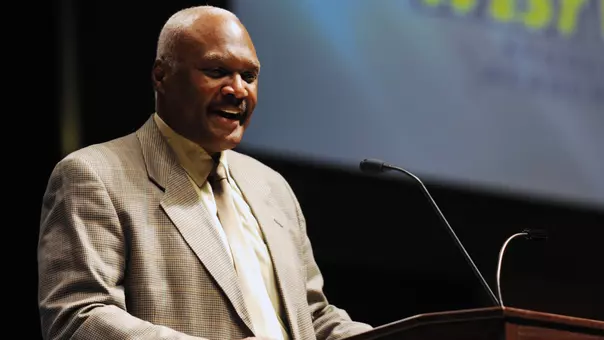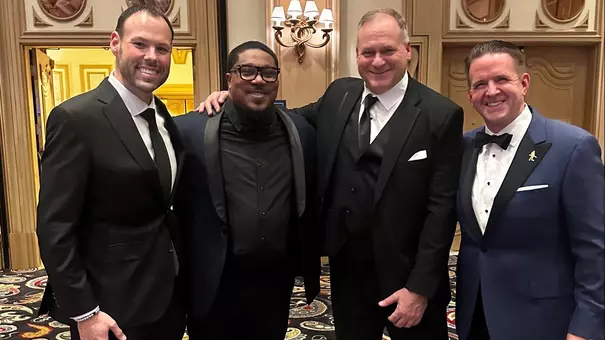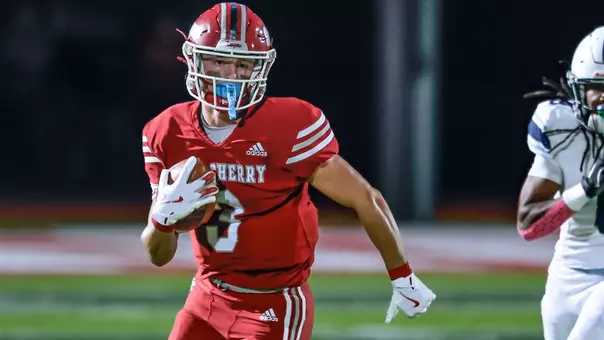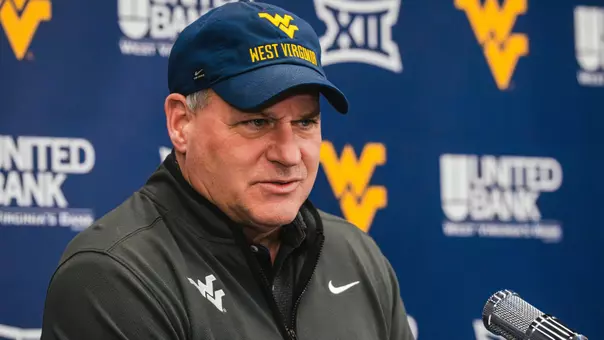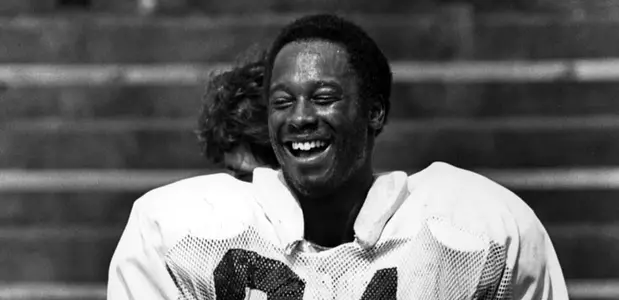
Alexander-Main-2116.jpg
WVU Once Inked Nation's No. 1 Prep Grid Player
February 01, 2016 08:38 PM | Football
On the front page of the Sunday, November 14, 1976, edition of the Sunday Charleston Gazette-Mail was the game story of West Virginia’s eight-point loss to top-ranked Pitt in Pittsburgh.
The Mountaineers that afternoon put up plenty of resistance against college football’s No. 1 team and its best player, Tony Dorsett.
In fact, if not for a late hit on Dorsett by West Virginia’s Robin Meeley and Dorsett’s response – he threw the ball at Meeley’s head, triggering a bench-clearing brawl - Dorsett would have had an NCAA-record-tying three straight 200-yard rushing performances to his credit. (It was later pointed out to me by a Penn State fan after reading my book “The Backyard Brawl” that Nittany Lion John Cappelletti had already accomplished the feat). As it were, Pitt’s Heisman Trophy winner finished the game with 199 yards before getting a head start to the showers with time still remaining on the clock.
At any rate, page two of that Sunday Gazette-Mail had additional coverage of the ’76 Backyard Brawl with two big action photos at the top. Below and off to the left was a picture of a young man decked out in a brown suit and top coat standing on Pitt’s sideline. Underneath the photo was the caption Alexander Begins Recruiting Season.
The young person in the picture was South Charleston’s Robert Alexander – the nation’s most coveted high school football player in 1977.
The Mountain State has produced better football players than Alexander, DuPont’s Randy Moss is far and away the best, and there have been better players than Alexander in the Kanawha Valley through the years.
Old-timers maintain quarterback Melvin Walker was the Capital City gold standard in the mid-1960s at Dunbar High. Walker, they say, was destined for stardom at Wisconsin until suffering an injury in a game against Minnesota in 1967 that eventually required his leg to be amputated below the knee.
Charleston High’s Mike Tyson (not to be confused with THE Mike Tyson) was an elite sprinter who earned a football/track scholarship to Iowa State in the early 1970s, but his career in Ames lasted all of one year there. He later tried to make the 1976 U.S. Olympic Team in the 200-meter dash before suffering a pulled hamstring in the qualifying round of the Olympic Trials that summer.
Moss, Walker, Tyson, and probably Monongah High running back Kerry Marbury up north were more physically gifted than Alexander, as were Martinsburg’s Fulton Walker (also in Alexander’s WVU signing class) and Pineville’s Curt Warner and Weirton’s Quincy Wilson who came along later, but no high school football player in West Virginia sports history matched the hype and publicity Robert Alexander generated in the winter of 1977.
Not before and not since.

Running back Robert Alexander, pictured here carrying the football against Colorado State in 1980 (WVU Athletic Communications photo).
As great as Randy Moss was at DuPont, personal difficulties in high school kept Moss from equaling the hysteria “Alexander the Great” created in the Mountain State when he was the No. 1 player on everyone’s recruiting board. As the calendar flipped toward February 1977, there were almost daily Robert Alexander updates in the state’s newspapers.
Was he really going to USC?
Was it going to be Ohio State?
Penn State? Pitt? Oklahoma? Michigan? UCLA?
Did West Virginia have any chance at all of keeping him home?
Keep in mind, this was the pre-Internet days when there were only a couple of high school All-America teams picked back then. Every school in the country that year sought Alexander’s services, some going to extremes to try and lure the country’s No. 1 rated player to their school.
“I think he’s the best running back east of the Mississippi,” said Penn State’s Joe Paterno.
“There’s sure a place in our program for him,” added Pitt coach Johnny Majors.
There is an urban legend still going around Charleston that Paterno, Woody Hayes and USC coach John Robinson were all standing together on the same field to watch one of Alexander’s South Charleston games, although Huntington Herald-Dispatch columnist Chuck Landon, who covered Alexander back then, believes it was to watch him practice instead.
When Frank Cignetti was hired to succeed Bobby Bowden as West Virginia’s football coach in January 1976, one of the first things Cignetti did was get on the telephone and call Robert Alexander.
“Robert Alexander is a must-get for our program,” Cignetti said at the time. “There are some players you must have to make your program a success – some recruits that are absolutely vital to get. Robert Alexander is one of those recruits.”
Cignetti placed such a high emphasis on Robert Alexander that he had his assistant coach, Garrett Ford, focus solely on him – Ford’s only recruiting responsibility that year. One player. All or nothing.
“I got an apartment down in Charleston and lived there five days out of the week,” Ford once recalled. “I was in Robert’s house more than he was. Hell, I even did their dishes.”
Back in the 1970s, recruiting rules were far more lenient than today. Probably three-fourths of what consists of today’s massive recruiting manual likely came out of that era of football recruiting.
Robert agreed to do a periodic recruiting diary with Wheeling Intelligencer sports editor Doug Huff, who was the first sports journalist in the state to really capitalize on the growing interest and popularity of high school sports. Huff later became a high school consultant for Street & Smith Magazine and eventually was the magazine’s No. 1 prep sports expert in the 1980s and 1990s, focusing on records and recruiting.
Charleston Daily Mail sports reporter Don Hager also developed a niche around the same time with his popular sports column filled with football and basketball recruiting tidbits, undoubtedly fueled by the Robert Alexander mania that took over the state in the mid-1970s.
Chemical Bank and Trust Company produced a four-color flyer of Alexander in his football uniform sitting on a wooden fence in front of South Charleston High that listed his major football accomplishments … the state and Kanawha Valley Conference records he set along with his career highlights.
And there were a lot of them.
During his senior season, in 1976, Alexander topped 300 yards in five out of the nine games he played, including a 344-yard, five-touchdown performance in his final game against Dunbar, despite sitting out the last nine minutes of South Charleston’s blowout victory.
He ran for 2,177 yards, scored 34 touchdowns and accounted for 220 points during his fantastic senior season – all state records at the time. His career totals showed 5,872 yards and 92 touchdowns, the Charleston sensation scoring a touchdown every nine times he touched the football and averaging 7.2 yards per carry.
Alexander was named the national high school player of the year by Parade Magazine and Joe Namath’s National Prep Sports, which wrote this of Alexander: “Several years ago, college scouts in the East were bragging about a young schoolboy product named Tony Dorsett. Today the same college scouts are saying the same about a youngster from West Virginia named Robert Alexander.”
“Robert had a target on his back from the time he was a freshman in high school,” recalled Huff, now retired. “He was a multi-sport guy, a 20-plus-point scorer on the basketball team and a baseball player in the spring. He was written about all over the country going into his senior year and during his senior year; there were columns on Robert in the Los Angeles Times and all over the place.”
When it came time for Alexander to make his college choice – West Virginia University – he did so at the governor’s mansion. By that time, every state politician worth his salt saw the value of attaching his name to Robert Alexander. There was even a Senate Resolution honoring Alexander’s terrific high school football career, which obviously passed unanimously.
The Senate Resolution, the signing ceremony at the governor’s mansion and Cignetti calling Alexander “The Franchise” made him the most eagerly anticipated football recruit in WVU football history.
Understandably, the schools that lost out to West Virginia were upset with Alexander’s decision.
“I don’t know of many other states where two governors and the state legislature would get involved in the recruiting of a high school football player,” Penn State assistant coach John Rosenberg told Associated Press sports writer Alan Robinson. “I know that Robert has set down many goals and ideals for himself, and I just hope all of this outside pressure did not steer him away from his own intentions.
“Tennessee is the only other state I can think of that has a similar situation,” Rosenberg continued. “In just about every other state it would be impossible for politicians to become involved in the recruiting of an athlete, no matter how good he is, simply because there are unusually more than several major schools involved.”
So, what became of the most coveted football recruit in West Virginia football history?
For the most part, Robert Alexander’s name has now been relegated to history, especially to Mountaineer fans aged 45 or younger.
He was considered a bust his first three seasons at WVU playing for Cignetti, but eventually he flourished as a senior in 1980 when Don Nehlen arrived and changed the offense to the I-formation with Alexander finally running behind a fullback.
Nehlen also didn’t recruit Alexander – he inherited him – which meant that all of the promises made to Alexander when he was being recruited went out the window.
It was Nehlen’s way or no way.
Alexander’s senior season saw him rush for 1,064 yards and score five touchdowns, including a career-high 189-yard performance in the first-ever game at Mountaineer Field against Cincinnati. Certainly, the switch from the Veer to the very popular I-formation attack of that time helped Alexander’s career, along with an improved cast of players surrounding him.
West Virginia didn’t really have a downfield passing game to complement Alexander’s running until Oliver Luck blossomed in 1980, or a big and experienced offensive line capable of creating the holes needed to get him out into the open.
Alexander also wasn’t quite as good as advertised. He had a tendency of fumbling, particularly early in his career, and he didn’t have great, straight-line speed. When he did get loose he was usually brought down from behind. On the longest run of Alexander’s career – a 69-yard jaunt against Kentucky during his junior season – he was tackled eight yards from reaching pay dirt.

A disturbing site: West Virginia's top prep football player Robert Alexander surrounded by Golden Panthers during a recruiting visit to Pitt in 1976 to watch the Panthers play West Virginia (Sam Sciullo Jr. photo).
He managed to score just eight rushing touchdowns in 40 career games – nothing close to what was expected of him coming out of high school.
Alexander did get drafted by the Los Angeles Rams and he spent parts of two seasons there in 1982-83 before catching on with the Los Angeles Express of the United States Football League in 1985, where he carried the ball four times for 27 yards that season.
In that respect, Alexander did fulfill a childhood dream of playing professional football. But was it the football career West Virginia fans had envisioned when Robert Alexander became the most heralded signee in school history?
No.
Based on my limited knowledge of football recruiting today, there are no Robert Alexanders in this year’s West Virginia signing class, to be officially unveiled right here on WVUsports.com Wednesday morning.
Come to think of it, there hasn’t been one since, well, Robert Alexander signed with West Virginia University back in 1977.
Rich Rodriguez | Dec. 3
Wednesday, December 03
Reid Carrico | Nov. 29
Saturday, November 29
Jeff Weimer | Nov. 29
Saturday, November 29
Rich Rodriguez | Nov. 29
Saturday, November 29
